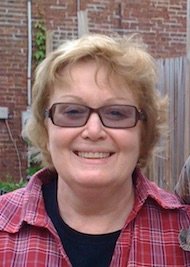
Mary McTamaney
By Mary McTamaney
Sensational things happened inside Newburgh, New York through the centuries. Today’s residents only learn about a fraction of them, even if they regularly read history books and seek out journal articles. That’s why it is a delight when someone comes across one of our old community stories and chooses to share it. Attorney and crime historian Alex Hortis discovered enough about a famous nineteenth century murder mystery and trial that he chronicled all its twists and turns in a book entitled, “The Witch Of New York.” He will share what he found in a presentation this Sunday at 3 p.m. in the place where it happened.
The 1846 trial took place inside the sleepy old courthouse at 123 Grand Street in Newburgh. That courthouse was then just five years old and the center of the village. It was built to hold the county courtroom, the judge’s chambers and the sheriff as well as the jail and was surrounded by a public park that the citizens paid for as a green resting and gathering space where they would sit and chat over the events of the day. The building still has the tall portico that served as a stage for parades, public speeches and musical concerts. Inside, the big courtroom was used not just for trials but for many village events like church services, political meetings and horticultural fairs. In its first decade, however, it had never hosted an event like the double murder trial of Mrs. Polly Bodine.
Polly Bodine was not a Newburgher. She wound up in the dock of the Newburgh Courthouse because her New York City trials – there had been two – had ended in a hung jury and a contested conviction. So, the New York District Attorney got a change of venue to a place up the Hudson where he hoped folks would not be so prejudiced by the wild claims made in America’s new media – the cheap tabloid press. Mrs. Bodine was from Staten Island and it was there that her sister-in-law and baby niece were found bludgeoned to death inside a burning house on Christmas night, 1843.
Mary Houseman Bodine, nicknamed Polly, presents a profile of the complications of life for women in post-colonial America. She lived next door to the murder victims, who were her brother’s family. She had been married young to a local sailor who turned abusive and usually drunk and who married again, never divorcing Polly. With two little children, and little legal rights and power, Polly fled back to her parents’ home for a time, but, as her children grew, she sought out a life for herself. Once an adventurous child with a tom-boy streak, she was often bold, drinking gin in the tavern with the men and frequently going over from Staten Island to Manhattan on the ferry. She had a long affair with her teenage son’s employer, a Manhattan druggist who was known to provide chemical mixtures to women for abortions. But could she be a murderer – and of a young mother and baby who were family to her?
Worn down emotionally and physically by her first two trials, a pale and frail Polly Bodine came to Newburgh to stand trial one final time. Here, she was represented by a team of lawyers similar to O.J. Simpson’s “dream team.” Led by former local congressman and former militia colonel, John W. Brown, Polly’s attorneys inside the Newburgh courthouse worked to not only refute the presented evidence but to ward off the steady attacks by salacious journalists who arrive in Newburgh like a second militia. The Bodine trial marks the first full assault on the news by a new American phenomenon, the tabloid press.
The lovely little green park between First and Second Streets that Newburghers used every day to watch the river together and exchange local news became a stage for a scandalous national event that consumed all other conversation. The crowds must have been overpowering to the neighbors in downtown Newburgh. Standard New York newspapers had reporters covering the case but new tabloids were sending their reporters too as independent writers came to town hoping to score a good story. Walt Whitman and Edgar Allan Poe were newspaper writers in 1846 and Horace Greeley, publisher of the New York Daily Tribune, was a close friend of P.T. Barnum who mounted a gruesome wax figure exhibit about Polly in his New York City museum.
One man has read through the thousands of pages of 19th century documentation to uncover the details of this story of the woman called “the Witch of New York.” This Sunday afternoon, April 21st, author Alex Hortis will share “The Trials of Polly Bodine and the Cursed Birth of Tabloid Justice” in a book talk at 3 p.m. at the Newburgh Heritage Center, 123 Grand Street, Newburgh. Golden Hour Books, Newburgh’s new independent bookstore, will be there selling copies of the history. All are welcome. Admission is free.